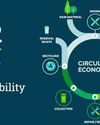PROCESSING OF ALGIKNIT FIBRES IN TEXTILE INDUSTRIES
Textile Value Chain
|October 2020
Climate change affects everyone – and the textile industry is not immune. Biomaterials research group AlgiKnit, is doing its bit for the environment by aiming to create a biomaterial alternative that serves as a replacement for everyday, man-made textiles such as polyester. Their goal is to keep fashion products from filling landfills and causing microplastic pollution.

Their goal is to create a sustainable BioYarn that can quickly biodegrade after its use-life is over and can be recycled through the earth’s biological systems. Chiefly, they are using alginate, a biopolymer derived from kelp, to do this. The seaweed is “rapidly replenishable and one of the fastest-growing organisms in the world”. The company is currently analysing its properties to see if the fibre is strong and flexible enough to be knitted on an industrial power machine.
The fashion industry is one of the biggest polluters on the planet. It is also a $1.2 trillion global industry, with more than $250 billion spent annually on fashion in the United States alone, according to industry analysts. AlgiKnit’s investors include RebelBio and SOSV, although the total investment amount is undisclosed. In 2017, AlgiKnit beat 2,800 submissions to win National Geographic’sChasing Genius award in the Sustainable Planet category, receiving the $25,000 prize along with three other ventures.
The goal of AlgiKnit is to eventually replace petroleum-based materials and become a go-to zero waste fabric suitable for clothing and footwear.AlgiKnit Inc. is a biomaterials company integrating science and design into textile production. Addressing the ecological damage caused by the fashion industry, AlgiKnit is creating durable yet rapidly degradable yarns.
They aim to operate in a closed-loop product lifecycle, utilizing materials with a significantly lower environmental footprint than conventional textiles, to bring sustainable bio-based textile alternatives to the footwear and apparel industries.
このストーリーは、Textile Value Chain の October 2020 版からのものです。
Magzter GOLD を購読すると、厳選された何千ものプレミアム記事や、10,000 以上の雑誌や新聞にアクセスできます。
すでに購読者ですか? サインイン
Textile Value Chain からのその他のストーリー

Textile Value Chain
EPR in Textiles: Turning Compliance into Opportunity
When the EU Comes to Panipat, It Means One Thing — The World Is Watching
3 mins
November 2025

Textile Value Chain
European Parliament Delegation Visits Panipat Recycling Cluster to Strengthen India-EU Collaboration on Circular Textiles
A high-level delegation from the European Parliament's Committee on International Trade (INTA) visited the Panipat Textile Recycling Cluster — India's largest hub for recycled textiles and circular manufacturing — during their official visit to India.
1 mins
November 2025

Textile Value Chain
Paramount Instruments: Where Innovation Turns Testing into Joy
At Paramount Instruments, innovation isn't just a Pursuit- it's in our DNA.
2 mins
November 2025
Textile Value Chain
Crafting the Future: LMW & Hami Weavelon pioneer Compact Spinning in Polyester
Manmade fibres today form the backbone of the global textile industry, driven by their versatility, performance, and ability to meet the rising demand for both everyday and specialised applications.
3 mins
November 2025

Textile Value Chain
Data is the New Thread: Weaving India's Textile Sector into a Circular Powerhouse
On November 13, 2025, at the 12th Edition of the India and Sustainability Standards (ISS) International Dialogue and Conference held at Bharat Mandapam in New Delhi, representatives from the Home Exporters Welfare Association of India (HEWA) joined industry leaders, policymakers, and international organizations to address a pressing question: How can India's textile sector meet emerging global data requirements while supporting its MSME backbone?
3 mins
November 2025

Textile Value Chain
Rieter Winding Suction Nozzle Upgrade: More Yarn, Less Energy Use
After upgrading the suction nozzles on their 32 winding machines, Sanyang Textile Co., Ltd., China, saw an increase in yarn production of 3% and a reduction of 13% in energy use. The flow-optimised, aerodynamically designed suction nozzle enables efficient upper yarn search and pickup from the package. This results in a 55% reduction in red light percentage and a significant reduction in the operator's workload.
1 mins
November 2025

Textile Value Chain
EU's Extended Producer Responsibility (EPR) Law and Its Implications for India's Textile Industry
The European Union (EU) has approved a new Extended Producer Responsibility (EPR) framework for textiles. This is a major regulatory shift that makes fashion brands and producers accountable for their products' entire lifecycle, from design and production through collection, sorting, recycling and disposal.
9 mins
November 2025

Textile Value Chain
GTE Ahmedabad 2025 Concludes Day 3 with a Huge Footfall
The 38th Garment Technology Expo (GTE) Ahmedabad 2025, co-located with the Lace & Trims Show, wrapped up its third day on an impressive note, recording around 9,700 B2B visitors. The strong industry turnout reaffirmed the expo's role as one of the most influential and business-driven platforms for garment and apparel technology in the western region.
2 mins
November 2025

Textile Value Chain
Reinterpreting Korean Street Fashion through Sustainable Design Practices
A Path through Eco-conscious Urban Fashion
7 mins
November 2025

Textile Value Chain
3D Printing in Textiles Manufacturing: A Game-Changer in Design, Sustainability, and Efficiency
The global textile and apparel industry is undergoing a radical transformation due to the convergence of digital design, advanced material technology, and next-generation manufacturing. Of the latter, few have greater potential to change how textiles are made today than additive manufacturing, better known as 3D printing.
5 mins
November 2025
Translate
Change font size

